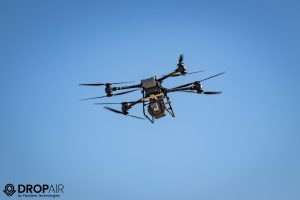Quad Nations’ Critical Minerals Initiative: What It Means for the Drone Industry
In July 2025, the collaborative group known as the “Quad”—comprised of Australia, India, Japan, and the United States—unveiled the Critical Minerals Initiative. This strategic venture addresses rising concerns over vulnerabilities in the global supply chain, particularly the over-dependence on China for vital rare earths and minerals. This development sends ripples across the drone industry, which heavily relies on these elements for essential components like batteries and sophisticated navigation systems.
Why Critical Minerals Matter for Drones
Drones, whether utilized for commercial, industrial, or defense applications, depend on various critical minerals for their celebrated lightness, endurance, power, and precision. These resources significantly affect drone technology in several ways:
- Structural Frame: Elements such as aluminum, magnesium, titanium, and scandium contribute to the high strength-to-weight ratios necessary for lightweight yet durable airframes.
- Propulsion & Motors: Rare earths like neodymium, praseodymium, and dysprosium are vital for manufacturing powerful, compact electric motors.
- Batteries: Lithium, nickel, and cobalt are pivotal to modern drone batteries, offering high capacity and quick recharge cycles.
- Electronics & Sensors: Minerals like beryllium, gallium, indium, and germanium provide critical support for precise navigation, communication, and sensor accuracy.
- Advanced Systems: Copper, hafnium, and other metals contribute to robustness and conductivity in high-performance components.
The reliance of the drone sector on these minerals makes it especially vulnerable to any disturbances or cost fluctuations in the global supply chain.
The Supply Chain Challenge: Why Take Action Now?
Historically, China has been the source of over 80% of rare earths for countries like the U.S., maintaining a similar dominance in processing and refining capabilities. This concentrated control has posed several risks:
- Economic Pressure: Export limits and tariffs can trigger immediate shortages and price surges, as seen with recent Chinese limits on rare earth exports, which spiked costs by 30–50% for crucial drone parts.
- National Security: Beyond photography, drones are integral to defense, logistics, energy, agriculture, and disaster response. Any supply interruption can have direct impacts on national security and critical infrastructure.
- Innovation Bottlenecks: A monopolized supply chain stifles competition and hinders technological progress.
Experts in the industry have highlighted how one country’s dominance in the supply and processing of critical minerals jeopardizes the drone sector and the broader tech economy with potential economic coercion and unpredictable shortages.
The Quad Critical Minerals Initiative: Ambitions and Mechanics
This initiative aims to transform global supply chains into systems that are robust, transparent, and resilient through:
- Joint Investment & Processing: A collaborative effort from 30–40 leading companies in Quad countries to develop shared processing and refining capabilities. This approach aims to domesticate the conversion of raw ore into usable materials, minimizing the bottleneck in processing stages.
- Promoting Recycling & Circular Economy: The Quad will advance the recycling of electronic waste and the recovery of critical minerals from aged electronics and batteries, enhancing sustainability through technology.
- Strategic Reserves and Inventory Buffers: Mirroring oil reserves management, the establishment of strategic mineral reserves may cushion against future market shocks.
- Shared R&D: By pooling resources and research expertise, the initiative seeks to fast-track the development of alternatives, recycling technologies, and exploration of new mining opportunities within member countries.
These measures are designed to not only benefit government or defense contractors but also encompass the entire industrial spectrum including consumer drones, agri-tech, logistics, surveying, and infrastructure inspection.
What Will Change for the Drone Industry?
For manufacturers and consumers, the Quad initiative could mean:
- Greater Supply Stability: Reduced risk of sudden shortages, less frequent price spikes, and more predictable long-term costs.
- Competitive Pricing and Innovation: A more competitive supplier market could lower component costs and hasten the creation of next-generation, high-performance drones.
- Strengthened National and Economic Security: Governments and defense entities gain enhanced access to crucial drone components, decreasing vulnerability to supply disruptions or geopolitical stresses.
- Faster Regulatory Adaptation: With a larger portion of the supply chain under domestic or allied oversight, regulatory dynamics can swiftly adapt to industry necessities, streamlining certification and export control processes.
Expert Insight: Industry Voices and Real-World Impact
According to Miriam McNabb, Editor-in-Chief of DRONELIFE, “the Quad’s commitment marks a new era of international collaboration, which could solidify a more secure foundation for industry growth and technological advancement.” Representatives from over 30 drone and tech companies within the Quad confirm active engagement, suggesting the potential for genuine, lasting change.
A noteworthy example is battery innovation: U.S. companies like Lyten have embarked on domestic production of advanced lithium-metal foils, integral to constructing new high-capacity drone batteries with locally sourced minerals.
Yet, as observed in 2024 when China employed export controls on elements like dysprosium and neodymium, U.S. drone manufacturers faced immediate delays and increased costs, underscoring the pressing need for diversified sourcing.
Potential Hurdles and Open Questions
While this initiative boasts ambitious goals, several challenges persist:
- Building New Processing Facilities: Establishing advanced refineries is capital-intensive and may take considerable time, with environmental, social, and regulatory clearances playing a crucial role.
- ESG and Community Engagement: Mining and refining activities necessitate addressing local community and environmental concerns, balancing strategic needs with sustainable development.
- Technological Substitution: Some critical minerals remain irreplaceable in drone tech, pressing for the discovery of alternatives or enhanced recycling techniques.
- Global Geopolitics: The Quad’s initiative may incite counteractions or new trade arrangements globally, further complicating the field.
Broader Implications: Beyond the Drone Industry
By investing in infrastructure for critical minerals, the Quad guarantees more than just the future for drones:
- Semiconductors: Sustained supply of critical metals essential for chip production.
- Electric Vehicles (EVs) and Energy Storage: Facilitating the transition to clean energy.
- Defense Systems: Fortifying national and allied security infrastructures.
This initiative stakes a claim on high-tech sovereignty and resilience, with the drone sector poised to emerge as a first and major beneficiary.
Key Takeaways for Drone Industry Stakeholders
- For manufacturers, anticipate improvements in material cost and supply consistency over the coming years as alternative suppliers emerge.
- For operators and end-users, the medium-term outlook may bring more affordable, higher-functioning drones with less risk of abrupt price swings or shortages.
- For investors, keep an eye on startups and tech companies from Quad countries focusing on battery innovations, recycling, or new propulsion materials.
- For governments and regulators, this is an opportunity to align national security goals with sustainable, high-growth industrial strategies.
Looking Ahead: A New Era of Drone Innovation
The Quad Critical Minerals Initiative stands beyond mere diplomatic moves, serving as a strategic directive to secure 21st-century technological foundations. Drones, once a science-fiction notion, now occupy pivotal roles in sectors like agriculture, logistics, defense, and infrastructure. Their future rests on a stable, ethical, and innovatively supplied mineral base.
The future promises not only faster and more durable drones but a novel framework for international technological cooperation, one that emphasizes resilience, sustainability, and mutual prosperity.
An industry expert noted at the recent Quad summit, “For drones to exceed limits, a reliable supply chain is crucial.”
For personalized advice, consulting, or industry news, connect with experts like Miriam McNabb and stay updated with leading outlets on developments in drones, critical minerals, and global tech trends.
The evolution of flight is unfolding now, fueled by crucial minerals, one step at a time.













